
Trophoblasts are the outermost cell layer of a blastocyst primarily responsible for the implantation process [1]. A trophoblast develops into extra-embryonic tissues, and these include the placenta. [2]
Trophoblasts are specialized cells that play a pivotal role in the early stages of mammalian development, particularly in the formation of the placenta. Originating from the outer layer of the blastocyst—the early stage embryo—trophoblast cells have the primary functions of facilitating embryo implantation and interfacing with the maternal endometrium to establish nutrient and waste exchange.
Trophoblasts also functions in controlling oxygen and metabolite exchange that transpires between the embryo and the mother [3]. Trophoblasts are also sometimes referred to as trophoderm. [4]
During early pregnancy, the trophoblast cells undergo differentiation and invasion, which are essential for placenta formation and successful pregnancy outcome. Differentiation includes the transformation from cytotrophoblasts to syncytiotrophoblasts and extravillous trophoblasts, as mentioned above.
[1] ^ Hibaoui, Youssef, and Anis Feki. 2013. Human pluripotent stem cells as alternative models to study trophoblast development. Frontiers in physiology (December 17). doi:10.3389/fphys.2013.00374. https://www.ncbi.nlm.nih.gov/pubmed/24381561
[2] ^ Morales-Prieto, D M, S Ospina-Prieto, A Schmidt, W Chaiwangyen, and U R Markert. 2013. Elsevier Trophoblast Research Award Lecture: origin, evolution and future of placenta miRNAs. Placenta (December 16). doi:10.1016/j.placenta.2013.11.017. https://www.ncbi.nlm.nih.gov/pubmed/24378039
[3] ^ Red-Horse, Kristy, Yan Zhou, Olga Genbacev, Akraporn Prakobphol, Russell Foulk, Michael McMaster, and Susan J Fisher. 2004. Trophoblast differentiation during embryo implantation and formation of the maternal-fetal interface. The Journal of clinical investigation, no. 6. https://www.ncbi.nlm.nih.gov/pubmed/15372095
[4] ^ Taga, Shigeki, Junko Haraga, Mari Sawada, Aya Nagai, Dan Yamamoto, and Ryoji Hayase. 2013. A case of placental mesenchymal dysplasia. Case reports in obstetrics and gynecology (November 20). doi:10.1155/2013/265159. https://www.ncbi.nlm.nih.gov/pubmed/24349807
Zombie cells, also called senescent cells, are non-dividing cells that accumulate in the body due to stress or damage, resisting… Read More
Chimeric antigen receptor-T cell treatment (CAR-T cell therapy) holds immense potential to revolutionize organ transplantation, particularly for patients who struggle… Read More
In the ever-evolving landscape of nutrition science, the discourse around dietary fats has undergone significant transformation. The Regeneration Center is… Read More
New research shows that specific types of brain cells become active after brain injuries and exhibit properties similar to those… Read More
Chemokines, critical components in the immune system, are small proteins that facilitate the migration and positioning of immune cells throughout… Read More
Stem cell research examines everything from gene expression to differentiation capacities to therapeutic potentials. With such diverse data types and… Read More